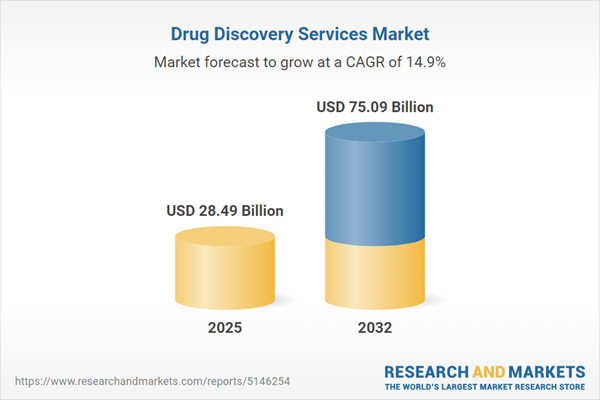Speak directly to the analyst to clarify any post sales queries you may have.
Senior decision-makers in the pharmaceutical and biotechnology sectors are increasingly turning to drug discovery services to streamline innovation, respond to evolving regulatory requirements, and address the complexity of today’s research pipelines. This shift empowers organizations to access specialist resources, enhance scientific rigor, and drive faster early-stage progress while maintaining operational flexibility.
Market Snapshot: Growth Outlook for the Drug Discovery Services Market
The drug discovery services market is projected to expand from USD 24.79 billion in 2024 to USD 28.49 billion in 2025, representing a 14.85% compound annual growth rate. This robust growth is being propelled by heightened demand for specialized providers capable of supporting advanced R&D initiatives and navigating regulatory updates. Key drivers include digital transformation, implementation of advanced automation, and growth in collaborative research models. Modern digital infrastructure and the adoption of integrated computational biology are enabling streamlined workflows and informed decision-making. The result is a resilient industry ready to manage intricate therapeutic pipelines and adjust to global market shifts.
Scope & Segmentation of the Drug Discovery Services Market
- Service Types: ADME DMPK testing, bioanalytical and pharmacokinetic support, and biomarker discovery across genomics, metabolomics, and proteomics, allowing for detailed molecular profiling and innovative candidate identification.
- Compound Development: Good Manufacturing Practice synthesis, medicinal chemistry, and both high-throughput and virtual screening approaches focused on optimal compound validation and quality assurance.
- Technologies: Computational biology, bioinformatics, cheminformatics, along with advanced instrumentation such as mass spectrometry, flow cytometry, nuclear magnetic resonance (NMR), and x-ray crystallography, underpin thorough analysis at every research phase.
- Molecule Types: Biologics, peptides, oligonucleotides, and small molecules are continually advancing new therapeutic designs for a diverse range of diseases.
- End Users: Academic institutions, biotechnological companies, contract research organizations, and pharmaceutical firms leverage these services to strengthen early research productivity and scale drug development.
- Therapeutic Areas: Cardiovascular, central nervous system, metabolic, infectious, and oncology research represent significant areas, supporting both common and rare disease studies through extensive service capabilities.
- Regions Covered: The market encompasses the Americas, Europe, Middle East and Africa, and Asia-Pacific. Market activity is prominent in the United States, China, India, and Japan. Emerging markets are impacting supplier strategies and compliance requirements across these regions.
- Key Companies: Leading participants include Charles River Laboratories International, Thermo Fisher Scientific, Labcorp, Evotec SE, IQVIA Holdings, Eurofins Scientific, Syngene International, Sai Life Sciences, TheraIndx Lifesciences, Drug Hunter, and Vipragen Biosciences, all offering extensive discovery research resources.
Key Takeaways for Senior Decision-Makers
- Strategic collaboration with specialized partners brings domain-specific knowledge and enables flexible engagement models aligned to evolving research demands.
- The integration of artificial intelligence and workflow automation supports real-time analysis and more confident decision-making across the drug development continuum.
- Growth in biomarker discovery and next-generation analytics is accelerating the move toward personalized medicine and enhancing targeted therapeutic development.
- Investments in multi-omics and advanced computational platforms are fostering wider global collaboration, expanding pipelines, and encouraging efficient data exchange between stakeholders.
- Continuous technological upgrades and digital process improvements help organizations remain agile in collaborative research settings while increasing R&D productivity.
- Greater attention to regulatory change and funding trends assists in project risk mitigation and informs strategic long-term planning initiatives.
Tariff Impact: Navigating Regulatory and Supply Chain Shifts
- Recent changes in US tariffs on research materials prompt organizations to re-evaluate supplier networks and consider nearshoring for cost containment and supply continuity.
- Expanding the pool of regional suppliers enhances risk management and ensures consistency amid evolving global logistics and compliance requirements.
- Intensified regulatory scrutiny by sponsors and providers is encouraging higher compliance standards, offering businesses greater resilience in unpredictable market environments.
Methodology & Data Sources
This analysis combines insights from executive interviews and regulatory reviews with evidence from peer-reviewed literature, public disclosures, intellectual property records, and proprietary industry datasets. The methodology delivers actionable, reliable market intelligence to guide strategic choices in the drug discovery services sector.
Why This Report Matters
- Enables senior leadership to make informed strategic decisions by providing tailored intelligence on innovation drivers, regulatory shifts, and evolving market conditions.
- Identifies high-value segment opportunities and potential risk areas, informing efficient capital allocation and organizational governance in rapidly changing research environments.
- Supports partnership development, regulatory compliance, and drives actionable insights for sustained competitive positioning in global markets.
Conclusion
Engagement with experienced drug discovery service providers empowers organizations to leverage advanced technologies, ensure regulatory compliance, and implement adaptive research and development approaches. Their expertise supports responsive, success-driven strategies in the continuously changing therapeutic landscape.
Additional Product Information:
- Purchase of this report includes 1 year online access with quarterly updates.
- This report can be updated on request. Please contact our Customer Experience team using the Ask a Question widget on our website.
Table of Contents
3. Executive Summary
4. Market Overview
7. Cumulative Impact of Artificial Intelligence 2025
List of Figures
Companies Mentioned
The companies profiled in this Drug Discovery Services market report include:- Charles River Laboratories International, Inc.
- Thermo Fisher Scientific Inc.
- Labcorp.
- Evotec SE
- IQVIA Holdings Inc.
- Eurofins Scientific SE
- Syngene International Ltd.
- Sai Life Sciences Limited
- TheraIndx Lifesciences Pvt. Ltd.
- Drug Hunter Inc.
- Vipragen Biosciences Private Limited
Table Information
| Report Attribute | Details |
|---|---|
| No. of Pages | 192 |
| Published | November 2025 |
| Forecast Period | 2025 - 2032 |
| Estimated Market Value ( USD | $ 28.49 Billion |
| Forecasted Market Value ( USD | $ 75.09 Billion |
| Compound Annual Growth Rate | 14.8% |
| Regions Covered | Global |
| No. of Companies Mentioned | 12 |









